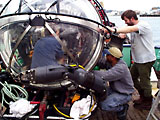 Today was spent on the Kaharoa. Preparing the Deep Rover for
routine diving operations after it had been shipped halfway around
the world is a fascinating process to watch, particularly if things
mechanical are of any interest to you. There are enough switches,
wires, hoses, clamps, connectors, valves, fittings and little
indicator lights to keep the most obsessive techie in heaven for
a very long time. In addition to everything that comes with the sub,
there are always additional scientific or photographic equipment
that needs to be installed on the sub or as in our case, some
specialized cameras that we will be using on this expedition that
will need to be attached on the outside of Deep Rover directly to the
manipulator arms.
Today was spent on the Kaharoa. Preparing the Deep Rover for
routine diving operations after it had been shipped halfway around
the world is a fascinating process to watch, particularly if things
mechanical are of any interest to you. There are enough switches,
wires, hoses, clamps, connectors, valves, fittings and little
indicator lights to keep the most obsessive techie in heaven for
a very long time. In addition to everything that comes with the sub,
there are always additional scientific or photographic equipment
that needs to be installed on the sub or as in our case, some
specialized cameras that we will be using on this expedition that
will need to be attached on the outside of Deep Rover directly to the
manipulator arms.
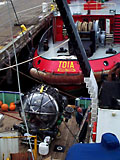
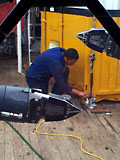 Thankfully, the weather has been fairly nice and the Deep Rover's
location on the fantail of the Kaharoa makes working all around it
fairly easy. Most everything that the sub's crew needs is within
easy reach inside one of the large shipping containers that has now
firmly secured to the deck of the Kaharoa with large chains and
turnbuckles. In case we encounter rough weather and heavy seas,
the last thing anybody wants is for that container to come loose
and start skidding across the deck. From the size of the chain they
used, I seriously doubt that this would be a problem.
Thankfully, the weather has been fairly nice and the Deep Rover's
location on the fantail of the Kaharoa makes working all around it
fairly easy. Most everything that the sub's crew needs is within
easy reach inside one of the large shipping containers that has now
firmly secured to the deck of the Kaharoa with large chains and
turnbuckles. In case we encounter rough weather and heavy seas,
the last thing anybody wants is for that container to come loose
and start skidding across the deck. From the size of the chain they
used, I seriously doubt that this would be a problem.
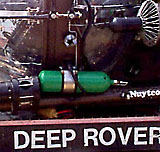 On either side of the Deep Rover are two
bright green tanks that look like the kind that scuba divers use. These
tanks contain the highly pressurized oxygen that the pilot breathes
during the dive and although most dives are usually only five or so
hours in duration, there is enough breathing oxygen on board for
at least 120 hours (five days). The only way that these little tanks
can hold that much oxygen is for it to be put under very high pressure.
In this case, the oxygen is packed into the tanks at 3000 psi (pounds
per square inch).
On either side of the Deep Rover are two
bright green tanks that look like the kind that scuba divers use. These
tanks contain the highly pressurized oxygen that the pilot breathes
during the dive and although most dives are usually only five or so
hours in duration, there is enough breathing oxygen on board for
at least 120 hours (five days). The only way that these little tanks
can hold that much oxygen is for it to be put under very high pressure.
In this case, the oxygen is packed into the tanks at 3000 psi (pounds
per square inch).
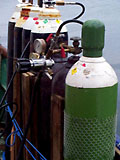
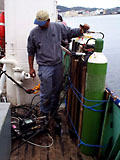 This morning Ian and the other members of the
Deep Rover's crew spent some time loading both Deep Rovers tanks with oxygen
from the large storage bottles that were secured along the port rail of the Kaharoa.
A special high powered pump called a Haskel's compressor took the
oxygen from the storage tanks and fed it into the Deep Rover's tanks until
they were full and at the desired pressure. Working with high pressure
oxygen is not something for amateurs since oxygen is a very flammable
gas and even the smallest spark could ignite it. The operation went smoothly
and both tanks were filled in preparation for the start of dive operations.
This morning Ian and the other members of the
Deep Rover's crew spent some time loading both Deep Rovers tanks with oxygen
from the large storage bottles that were secured along the port rail of the Kaharoa.
A special high powered pump called a Haskel's compressor took the
oxygen from the storage tanks and fed it into the Deep Rover's tanks until
they were full and at the desired pressure. Working with high pressure
oxygen is not something for amateurs since oxygen is a very flammable
gas and even the smallest spark could ignite it. The operation went smoothly
and both tanks were filled in preparation for the start of dive operations.
Normally the Deep Rover is a free diving submersible, meaning that once it
enters the water and is disconnected from the winch cable that is used to
raise and lower it, there is nothing attaching it to the ship. Deep Rover
can go up and down and maneuver pretty much anywhere the pilot wishes to
go as long as it is done in coordination with the folks on the surface support
ship. For this expedition, things are going to be a little different because we
want to be able to get live video images from the cameras on the sub
during each of the dives.

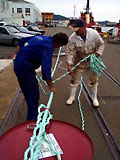 To do that, a special fiber optic cable is going to be
used that can carry the video signals back to the ship where they can
be watched by the scientists on board (only one person is lucky enough to
actually go down in Deep Rover) and recorded for later analysis.
Since the fiber optic cable is not very strong and can also be pretty
easily damaged, it is going to be attached to a very strong tether made out
of a rope-like material called poly-steel. Since it is rare to find a single
rope as long as is going to be needed for our dives, two of the Kaharoa's
crew spent a few hours this afternoon splicing two large coils of line together
on the dock alongside the ship.
To do that, a special fiber optic cable is going to be
used that can carry the video signals back to the ship where they can
be watched by the scientists on board (only one person is lucky enough to
actually go down in Deep Rover) and recorded for later analysis.
Since the fiber optic cable is not very strong and can also be pretty
easily damaged, it is going to be attached to a very strong tether made out
of a rope-like material called poly-steel. Since it is rare to find a single
rope as long as is going to be needed for our dives, two of the Kaharoa's
crew spent a few hours this afternoon splicing two large coils of line together
on the dock alongside the ship.
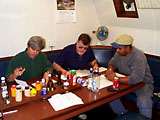 Late this afternoon Ian, Mike and Clyde sat around the table in the Kaharoa's
galley and began their formal Deep Rover pilot training. Although I will not have a
chance to actually take the Deep Rover down for a dive, I will be following
the actual training so that I can describe as best I can all the steps that
Mike and Clyde will be going through so that they can learn to take
Deep Rover down to the depths of Kaikoura Canyon. Everything that Deep
Rover does and every action that the pilot needs to take is generally spelled
out in some way in a series of checklists and procedures. It is Ian's job
to teach Mike and Clyde all these things over the next few days so that they
can be able to deal with any situation that may arise. There were a few points
that Ian made during that initial training session that struck me as things that
may have seemed pretty intuitive at first, but after thinking about them, were very
critical to remember. Some of the ones that really stuck with me were:
Late this afternoon Ian, Mike and Clyde sat around the table in the Kaharoa's
galley and began their formal Deep Rover pilot training. Although I will not have a
chance to actually take the Deep Rover down for a dive, I will be following
the actual training so that I can describe as best I can all the steps that
Mike and Clyde will be going through so that they can learn to take
Deep Rover down to the depths of Kaikoura Canyon. Everything that Deep
Rover does and every action that the pilot needs to take is generally spelled
out in some way in a series of checklists and procedures. It is Ian's job
to teach Mike and Clyde all these things over the next few days so that they
can be able to deal with any situation that may arise. There were a few points
that Ian made during that initial training session that struck me as things that
may have seemed pretty intuitive at first, but after thinking about them, were very
critical to remember. Some of the ones that really stuck with me were:
- Always know where you have been and plan where you are going
- The only thing that does not have a fully redundant system on the
Deep Rover is the logical, thinking person inside it.
- The surface crew and pilot act as a team.
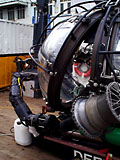
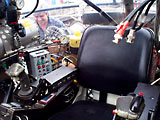 One of the things that I had been looking forward to ever since I learned
that I would be coming on this expedition was the chance to actually
get inside Deep Rover. Today was the day I got to do just that.
After the first training session was over and before we headed back to town,I spent about an hour inside the sphere, sitting in the pilot's seat and
trying to familiarize myself with anything that I could see, touch or hear.
You get into Deep Rover through a very narrow opening that is created
when they separate the two halves of the pressure sphere using that large
threaded rod that brings the two parts together.
You go in facing the stern
and then pivot around and drop into the seat. I'll be describing in as
much detail
as i can the various systems inside Deep Rover in later dispatches but for
now, it was enough for me to just sit and look around in complete fascination.
One of the things that I had been looking forward to ever since I learned
that I would be coming on this expedition was the chance to actually
get inside Deep Rover. Today was the day I got to do just that.
After the first training session was over and before we headed back to town,I spent about an hour inside the sphere, sitting in the pilot's seat and
trying to familiarize myself with anything that I could see, touch or hear.
You get into Deep Rover through a very narrow opening that is created
when they separate the two halves of the pressure sphere using that large
threaded rod that brings the two parts together.
You go in facing the stern
and then pivot around and drop into the seat. I'll be describing in as
much detail
as i can the various systems inside Deep Rover in later dispatches but for
now, it was enough for me to just sit and look around in complete fascination.
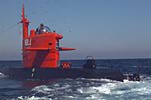
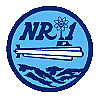 Being in Deep Rover is an incredible experience, and very unlike my
previous experiences inside research submarines. On the Navy's
NR-1, although the submersible is quite large and can carry thirteen people,
the actual observation space is pretty cramped and dark. You lie on your stomach
underneath the navigation area and peer out of small portholes towards the bottom.
On the Alvin, which like the Deep Rover I only sat inside and did not get to dive
in, the conditions felt even more confined. Three people in a small
sphere without anyplace to stretch out. However, each submersible has it's
own strengths and both Alvin and NR-1 are unquestionably incredible diving
machines. The only thing that I am comparing here is my first impression of
the space available to the pilot/observer and the feeling that you have once
you get inside.
Being in Deep Rover is an incredible experience, and very unlike my
previous experiences inside research submarines. On the Navy's
NR-1, although the submersible is quite large and can carry thirteen people,
the actual observation space is pretty cramped and dark. You lie on your stomach
underneath the navigation area and peer out of small portholes towards the bottom.
On the Alvin, which like the Deep Rover I only sat inside and did not get to dive
in, the conditions felt even more confined. Three people in a small
sphere without anyplace to stretch out. However, each submersible has it's
own strengths and both Alvin and NR-1 are unquestionably incredible diving
machines. The only thing that I am comparing here is my first impression of
the space available to the pilot/observer and the feeling that you have once
you get inside.
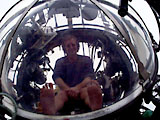 Deep Rover provides a completely different feeling from the other two. In
Deep Rover you are sitting inside a bubble of clear acrylic, five inches think.
It is difficult for me to describe what it felt like except to say that there was
no feeling of being cramped or confined. The acryllic was so clear and because
there was hardly any distortion, it felt completely open and comfortable to me.
However, since I will not be diving, I am going to have to ask Mike and Clyde
for their impressions of what it is like to be underwater in Deep Rover
once they return from their first dives. But for now, i was perfectly content
to just sit there and imagine......
Deep Rover provides a completely different feeling from the other two. In
Deep Rover you are sitting inside a bubble of clear acrylic, five inches think.
It is difficult for me to describe what it felt like except to say that there was
no feeling of being cramped or confined. The acryllic was so clear and because
there was hardly any distortion, it felt completely open and comfortable to me.
However, since I will not be diving, I am going to have to ask Mike and Clyde
for their impressions of what it is like to be underwater in Deep Rover
once they return from their first dives. But for now, i was perfectly content
to just sit there and imagine......
best regards,
gene

 Thankfully, the weather has been fairly nice and the Deep Rover's
location on the fantail of the Kaharoa makes working all around it
fairly easy. Most everything that the sub's crew needs is within
easy reach inside one of the large shipping containers that has now
firmly secured to the deck of the Kaharoa with large chains and
turnbuckles. In case we encounter rough weather and heavy seas,
the last thing anybody wants is for that container to come loose
and start skidding across the deck. From the size of the chain they
used, I seriously doubt that this would be a problem.
Thankfully, the weather has been fairly nice and the Deep Rover's
location on the fantail of the Kaharoa makes working all around it
fairly easy. Most everything that the sub's crew needs is within
easy reach inside one of the large shipping containers that has now
firmly secured to the deck of the Kaharoa with large chains and
turnbuckles. In case we encounter rough weather and heavy seas,
the last thing anybody wants is for that container to come loose
and start skidding across the deck. From the size of the chain they
used, I seriously doubt that this would be a problem.
 On either side of the Deep Rover are two
bright green tanks that look like the kind that scuba divers use. These
tanks contain the highly pressurized oxygen that the pilot breathes
during the dive and although most dives are usually only five or so
hours in duration, there is enough breathing oxygen on board for
at least 120 hours (five days). The only way that these little tanks
can hold that much oxygen is for it to be put under very high pressure.
In this case, the oxygen is packed into the tanks at 3000 psi (pounds
per square inch).
On either side of the Deep Rover are two
bright green tanks that look like the kind that scuba divers use. These
tanks contain the highly pressurized oxygen that the pilot breathes
during the dive and although most dives are usually only five or so
hours in duration, there is enough breathing oxygen on board for
at least 120 hours (five days). The only way that these little tanks
can hold that much oxygen is for it to be put under very high pressure.
In this case, the oxygen is packed into the tanks at 3000 psi (pounds
per square inch).
 Today was spent on the Kaharoa. Preparing the Deep Rover for
routine diving operations after it had been shipped halfway around
the world is a fascinating process to watch, particularly if things
mechanical are of any interest to you. There are enough switches,
wires, hoses, clamps, connectors, valves, fittings and little
indicator lights to keep the most obsessive techie in heaven for
a very long time. In addition to everything that comes with the sub,
there are always additional scientific or photographic equipment
that needs to be installed on the sub or as in our case, some
specialized cameras that we will be using on this expedition that
will need to be attached on the outside of Deep Rover directly to the
manipulator arms.
Today was spent on the Kaharoa. Preparing the Deep Rover for
routine diving operations after it had been shipped halfway around
the world is a fascinating process to watch, particularly if things
mechanical are of any interest to you. There are enough switches,
wires, hoses, clamps, connectors, valves, fittings and little
indicator lights to keep the most obsessive techie in heaven for
a very long time. In addition to everything that comes with the sub,
there are always additional scientific or photographic equipment
that needs to be installed on the sub or as in our case, some
specialized cameras that we will be using on this expedition that
will need to be attached on the outside of Deep Rover directly to the
manipulator arms.







